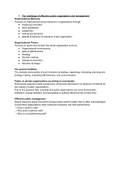Samenvatting
Summary Understanding and Managing Public Organizations, Fifth Edition - Rainey, Hal G (1)
- Instelling
- Universiteit Twente (UT)
Summary of the book Understanding and Managing Public Organizations, Fifth Edition by Rainey, Hal G. Summary is completely written in English. Book is used in courses related to the management of public organizations. Chapter 12 can be seen as a bit short but I felt like most information in there...
[Meer zien]






